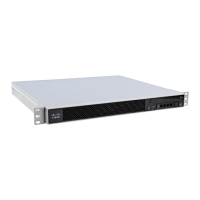14-28
Cisco ASA Series Firewall CLI Configuration Guide
Chapter 14 Inspection for Voice and Video Protocols
SIP Inspection
hostname(config)# policy-map type inspect sip sample_sip_map
hostname(config-pmap)# parameters
hostname(config-pmap-p)# trust-verification-server ip 10.1.1.1
hostname(config-pmap-p)# trust-verification-server ip 10.1.1.2
hostname(config-pmap-p)# trust-verification-server ip 10.1.1.3
hostname(config-pmap-p)# trust-verification-server ip 10.1.1.4
hostname(config-pmap-p)# trust-verification-server port 2445
Configure the SIP Inspection Service Policy
The default ASA configuration includes SIP inspection on the default port applied globally on all
interfaces. A common method for customizing the inspection configuration is to customize the default
global policy. You can alternatively create a new service policy as desired, for example, an
interface-specific policy.
Procedure
Step 1 If necessary, create an L3/L4 class map to identify the traffic for which you want to apply the inspection.
class-map name
match parameter
Example:
hostname(config)# class-map sip_class_map
hostname(config-cmap)# match access-list sip
In the default global policy, the inspection_default class map is a special class map that includes default
ports for all inspection types (match default-inspection-traffic). If you are using this class map in
either the default policy or for a new service policy, you can skip this step.
For information on matching statements, see Identify Traffic (Layer 3/4 Class Maps), page 11-13.
Step 2 Add or edit a policy map that sets the actions to take with the class map traffic.
policy-map name
Example:
hostname(config)# policy-map global_policy
In the default configuration, the global_policy policy map is assigned globally to all interfaces. If you
want to edit the global_policy, enter global_policy as the policy name.
Step 3 Identify the L3/L4 class map you are using for SIP inspection.
class name
Example:
hostname(config-pmap)# class inspection_default
To edit the default policy, or to use the special inspection_default class map in a new policy, specify
inspection_default for the name. Otherwise, you are specifying the class you created earlier in this
procedure.
Step 4 Configure SIP inspection.
inspect sip [sip_policy_map] [tls-proxy proxy_name]
Where:

